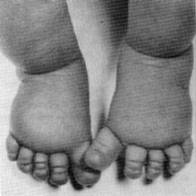Turner syndrome facts for kids
Turner syndrome is a genetic condition that affects girls and women. It happens when a girl is missing all or part of one of her two X chromosomes. Normally, girls have two X chromosomes, but with Turner syndrome, one is either gone or incomplete. This condition is also sometimes called "45,X" because people usually have 46 chromosomes, but those with Turner syndrome have 45.
Turner syndrome is not very common. It affects about 1 out of every 2,000 to 5,000 girls born. It's much more common for a pregnancy to start with Turner syndrome, but most of those pregnancies do not continue to full term.
Contents
What are the Signs of Turner Syndrome?
Girls with Turner syndrome can have different signs and symptoms. Some common physical features include a short neck that might look "webbed," being shorter than average, having a broad chest, and a low hairline at the back of the neck.
Health Challenges
Girls with Turner syndrome might also face certain health challenges. These can include:
- Heart problems, which might need special care.
- Hypothyroidism, which means their thyroid gland doesn't make enough hormones.
- Diabetes, a condition where the body has trouble controlling blood sugar.
- Autoimmune diseases, where the body's immune system mistakenly attacks healthy cells.
- Infertility, meaning they might have difficulty having children when they grow up.
It's important to know that most girls with Turner syndrome have normal intelligence. However, some might have specific learning differences.
Growth and Learning
Many girls with Turner syndrome are shorter than other girls their age. To help them grow, some girls receive a special medicine called Human Growth Hormone (hGH). This hormone helps the body grow and develop.
Learning Differences
Some girls with Turner syndrome may have certain learning differences. These usually involve things that are not related to reading or talking. For example, they might have trouble with:
- Visual skills, like understanding maps or puzzles.
- Motor coordination, which affects how they move their bodies.
- Spatial perception, which is understanding where objects are in space.
These learning differences mean they might need extra support in school, especially in subjects like math or activities that require good hand-eye coordination.
Images for kids
-
45,X karyotype, showing an unpaired X at the lower right
See also
 In Spanish: Síndrome de Turner para niños
In Spanish: Síndrome de Turner para niños



